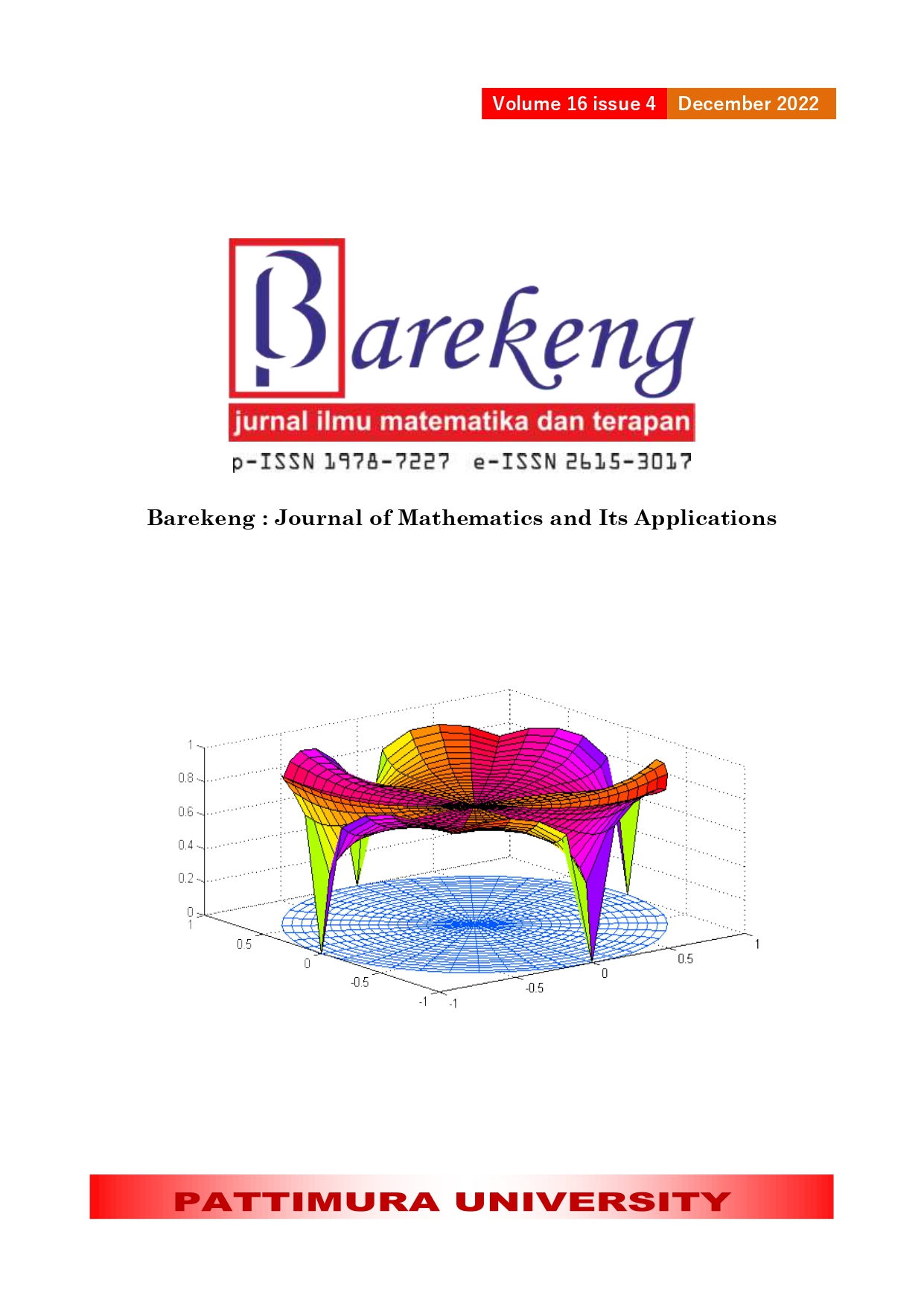INVERSE GAUSSIAN REGRESSION MODELING AND ITS APPLICATION IN NEONATAL MORTALITY CASES IN INDONESIA
Abstract
Inverse Gaussian Regression (IGR) is a suitable model for modeling positively skewed response data, which follows the inverse Gaussian distribution. The IGR model was formed from the Generalized Linear Models (GLM). This study aims to model the IGR with applied to model the factors influencing the infant mortality cases of provinces in Indonesia. Estimation of the IGR model parameters was employed by the Maximum Likelihood Estimation (MLE) and Fisher scoring methods. The Likelihood Ratio Test (LRT) and Wald test were used for hypothesis testing of significance parameters. The IGR model was applied to the infant mortality cases of provinces in Indonesia in 2020. The data for modeling infant mortality cases using IGR were obtained from the Ministry of Health of the Republic of Indonesia and the Central Bureau of Statistics. The result shows that the factors influencing the infant mortality cases of provinces in Indonesia based on the IGR model were: the percentage of pregnant women who received blood-boosting tablets, the percentage of low birth weight, the percentage of complete neonatal visits (KN3), the percentage of toddlers who received early initiation of breastfeeding, the percentage of toddlers who are exclusively breastfeeding, the percentage of toddlers who received complete primary immunization, the percentage of households with access to adequate drinking water, and the percentage of households with access to appropriate sanitation.
Downloads
References
S. Kinat, M. Amin and T. Mahmood, "GLM-based control charts for the inverse Gaussian response variable," Qual. Reliab. Eng. Int., vol. 36, no. 2, pp. 765-783, March 2020.
M. N. Akram, M. Amin and M. Qasim, "A new Liu-type estimator for the inverse Gaussian regression model," J. Stat. Comput. Simul., vol. 90, no. 7, pp. 1153-1172, January 2020.
I. A. Koutrouvelis and A. Karagrigoriou, "Cumulant plots and goodness-of-fit tests for the inverse Gaussian distribution," J. Stat. Comput. Simul., vol. 82, no. 3, pp. 343-358, 2012.
L. Wu and H. Li, "Variable selection for joint mean and dispersion models of the inverse Gaussian distribution," Metrika, vol. 6, pp. 795-808, 2012.
J. A. Villasenor and E. Gonzalez-Estrada, "Tests of fit inverse Gaussian distribution," Stat. Probab. Lett., vol. 105, pp. 189-194, 2015.
J. A. Villasenor, E. Gonzalez-Estrada and A. Ochoa, "On testing the inverse Gaussian hypothesis," Sankhya: Indian J. Stat., doi: 10.1007/s13571-0170148-8, pp. 1-14, 2017.
E. Gonzalez-Estrada and J. A. Villasenor, "An R package for testing goodness of fit: goft," J. Stat. Comput. Simul., vol. 88, no. 4, pp. 726-751, 2018.
S. Kinat, M. Amin and T. Mahmood, "GLM-based control charts for the inverse Gaussian response variable," Qual. Reliab. Eng. Int., doi: 10.1002/qre.2603, pp. 1-19, 2019.
Z. Y. Algamal, "Performance of ridge estimator in inverse Gaussian regression model," Commun. Stat. Theor. Method., vol. 48, no. 15, pp. 3836-3849, 2019.
R. E. Shamany, N. Z. Alobaidi and Z. Y. Algamal, "A new two-parameter estimator for the inverse Gaussian regression model with application in chemometrics," Electron. J. Appl. Stat. Anal., vol. 12, no. 2, pp. 453-464, 2019.
Y. M. Bulut and M. Isilar, "Two parameter Ridge estimator in the inverse Gaussian regression model," Hacet. J. Math. Stat., vol. 50, no. 3, pp. 895-910, 2021.
A. Lukman, Z. Y. Algamal, B. M. G. Kibria and K. Ayinde, "The KL estimator for the inverse Gaussian regression model," Concurr. Comput. Pract. Exp., vol. 33, no. 13, pp. 1-9, 2021.
The Ministry of Health of the Republic of Indonesia, Demographic Survey and Basic Health Research (RISKESDAS), Jakarta: The Ministry of Health of the Republic of Indonesia, 2018.
WHO, World Health Statistics 2020: Monitoring Health for the Sustainable Development Goals, Geneva: WHO, 2020.
F. Rumiaty and A. C. Adisasmita, "Determinants of neonatal mortality based on the 2017 Indonesian Demographic and Health Surveys (IGHS)," Indonesian J. Public. Health., vol. 16, no. 3, pp. 363-374, 2021.
UNICEF, Levels & Trends in Child Mortality 2018, New York: UNICEF, 2018.
The Ministry of Health of the Republic of Indonesia, The Indonesian Profile of Health 2020, Jakarta: The Ministry of Health of the Republic of Indonesia, 2021.
A. Agresti, Foundations of Linear and Generalized Linear Models, New Jersey: John Wiley & Sons, 2015.
M. Fathurahman, "Pemodelan indeks pembangunan kesehatan masyarakat kabupaten/kota di Pulau Kalimantan menggunakan pendekatan regresi probit [Modeling the public health development index of districts/cities in Kalimantan Island using probit regression approach]," J. Varian, vol. 2, no. 2, pp. 47-54, 2019.
P. K. Dunn and G. K. Smyth, Generalized Linear Models with Examples in R, New York: Springer, 2018.
H. Wickham, ggplot2: Elegant Graphics for Data Analysis, 2nd ed., Switzerland: Springer, 2016.
W. H. Greene, Econometric Analysis, 7th ed., New York: Pearson Education, 2012.
Copyright (c) 2022 M. Fathurahman

This work is licensed under a Creative Commons Attribution-ShareAlike 4.0 International License.
Authors who publish with this Journal agree to the following terms:
- Author retain copyright and grant the journal right of first publication with the work simultaneously licensed under a creative commons attribution license that allow others to share the work within an acknowledgement of the work’s authorship and initial publication of this journal.
- Authors are able to enter into separate, additional contractual arrangement for the non-exclusive distribution of the journal’s published version of the work (e.g. acknowledgement of its initial publication in this journal).
- Authors are permitted and encouraged to post their work online (e.g. in institutional repositories or on their websites) prior to and during the submission process, as it can lead to productive exchanges, as well as earlier and greater citation of published works.






1.gif)



